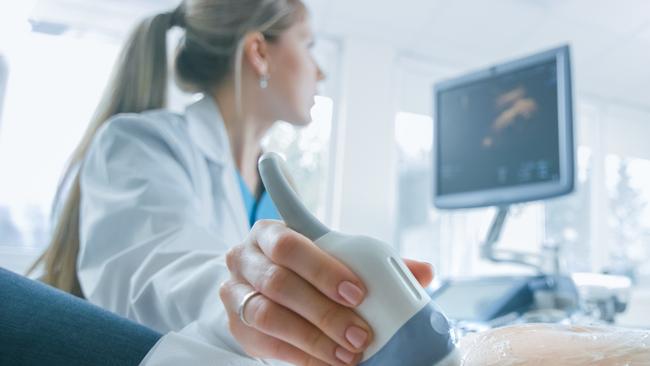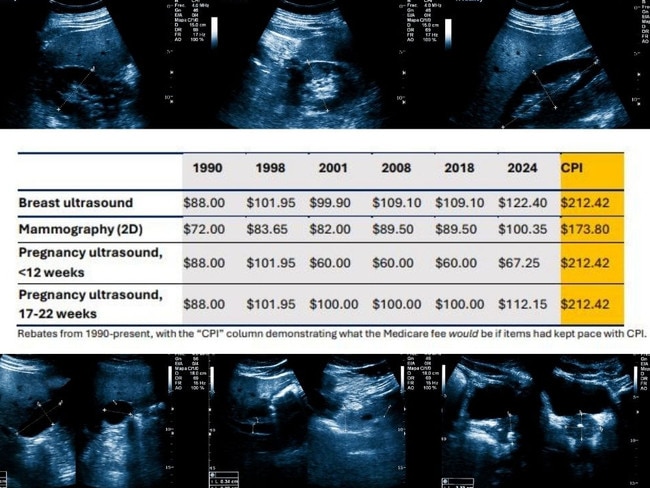ADIA urges the government to fix gender gaps in Medicare imaging rebates which are stuck in the ‘90s
Pregnant women are getting less money back for ultrasounds than they did three decades ago, prompting Australia’s peak imaging body to renew calls for urgent government reform.

Cairns
Don't miss out on the headlines from Cairns. Followed categories will be added to My News.
Pregnant women are getting less money back for ultrasounds than they did three decades ago, prompting Australia’s peak imaging body to renew calls for urgent government reform.
According to the Australian Diagnostic Imaging Association, in 1990, women got $88 back from Medicare for a pregnancy ultrasound done before 12 weeks.
But ADIA says if this had kept up with CPI, the rebate in 2024 would be $212.42 — instead of the dismal $67.25 it currently is.
ADIA president Dr Ron Shnier said women’s imaging services were among the most underfunded areas of Medicare, with rebates not keeping up with the rising cost of living.
“We’ve been advocating for improved Medicare funding for women’s imaging for some time,” he said.
“Identifying any gender bias in Medicare rates appears to have stalled, but the underlying issues remain.”

It comes after the Cairns Post launched Critical Condition earlier this year; a campaign that highlighted significant wait times for women being diagnosed with breast cancer, and resulted in the successful reinstatement of a lost diagnostic service earlier this year.
On Thursday the CQUniversity also received bipartisan support for a new health wing.
As part of the commitment, radiology imaging training will be offered in Cairns in 2026.
ADIA had been hopeful the review would finally signal an end to the “ever-widening” gap in out-of-pocket expenses for women.
“While we were encouraged by the announcement of a review in the last budget, we are yet to see any meaningful improvement.”

Mammography rebates have similarly failed to keep pace with inflation.
In 1990, the rebate for a mammogram was $72. In the past 30 years, this amount has increased by just $28.35, bringing the current rebate for a 2D mammogram to $100.35.
Reimbursement rates for other women’s imaging services, including breast ultrasounds and pregnancy ultrasounds between 17 and 22 weeks, have also lagged behind the rising cost of CPI.
Had rebates kept up with inflation, women would now be receiving $90 more for breast ultrasounds and up to $145 more for pregnancy ultrasounds than they currently are.
In February, the Department of Health and Aged Care confirmed it met with key groups including ADIA to discuss access to imaging services, workforce shortages, and gender disparities.
While workforce issues were flagged as a major barrier to access in regional areas, the federal government also conducted a gender audit of the Medicare Benefits Schedule.
Launching a review of selected diagnostic imaging services, the audit examined gaps in imaging rebates for women, as part of the 2024–25 budget.
This review looked at the costs and clinical guidelines for breast and ultrasound imaging, aiming to keep services accessible, affordable and improve access to essential women’s health services.
The department completed a public consultation in December 2024, and had been reviewing the feedback received.
“We are disappointed that a patient bill relief scheme is again missing from this year’s budget,” Dr Shnier said.
Dr Shnier said a fix was needed for the outdated billing system which is causing pain for millions of Australians every year.
“With a federal election imminent, we call on both major parties to commit to targeted rebate increases to make crucial women’s services more accessible and affordable,” he said.
It is understood indexation for all diagnostic imaging items were frozen from 1998 until 2020, with the freeze meaning fees for imaging services did not keep pace with inflation or the increasing costs of medical services.

The 2024–25 budget included a review of gender bias in Medicare costs, especially for certain scans.
After public consultation, the review found urgent needs—like better access to ultrasounds for severe endometriosis—and highlighted the necessity to remove administrative barriers, such as co-claiming restrictions.
Funding for these changes was included in the 2025–26 budget.
It is further understood following the caretaker period, the department will work with breast imaging and ultrasound groups and consult the wider health sector to develop updated arrangements.
The public will be asked for feedback, including doctors, patients, and health groups, which will help shape the final recommendations.
These responses will be reviewed by a medical advisory committee before going to the government.
A final report is expected in early 2026 with the government to consider the final report through a future budget process.
The federal government was contacted for comment.
More Coverage
Originally published as ADIA urges the government to fix gender gaps in Medicare imaging rebates which are stuck in the ‘90s





